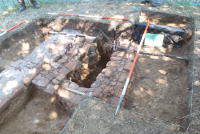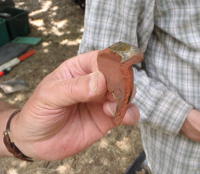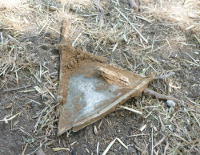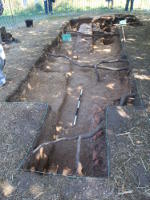19 Jul 2015
Festival Of Archaeology 2015 - Forty Hall - Day 6

An arduous but thoroughly rewarding final day's digging in Forty Hall saw the sun shine despite poor forecasts, which thankfully let us crack on and achieve almost all of our principal objectives, and brought a sizeable crowd to witness the fantastic archaeology our trench finally produced.
Yesterday we had removed most of a top layer of sandy rubble from the top of our newly discovered garderobe chute -- the layer below seemed to be more solid and our hopes that it would contain useful finds were thoroughly fulfilled.

The first thing we found was evidence that our garderobe chute was actually divided into two compartments -- ephemeral brickwork and lots of large nails suggest it may have been originally partitioned by a mostly wooden screen.
Amongst this rubble were three different deliberately shaped bricks -- elements of the more elaborate palace architecture such as the decorative window surrounds, and perhaps even a corbel. One such brick even had signs of 'ruddling' -- painting with a red ochre compound, which is known on other Tudor palaces such as Hampton Court.
There was a modest amount of pottery, including a small cooking pot with green mottled glaze on the rim (pictured), and part of the base of a 'pipkin' -- a small cooking pot with tripod legs -- excitingly this still had a sooty base from the final time it had a fire lit beneath it, at least three centuries ago!

The most interesting part of the chute fill, however, was a dense layer of window glass, including fragments of the lead 'cames' which originally joined them together -- these became increasingly more frequent and the glass pieces bigger and bigger until the star find of the dig emerged -- an intact window panel still set in its original lead cames.
This is a fantastically rare find, not only to have survived the brutal demolition process and scavenging of lead, which was the norm, but the glass and lead have both become heavily oxidised and extremely brittle, and so far only one informal picture was able to be taken before it was quickly placed in protective wrapping to be sent for painstaking conservation.
Because of the heavy oxidation, it is not yet clear whether any of the glass is painted, but even if not, this panel is a find of national significance.

Elsewhere in the trench, the heavily robbed-out wall was traced in a stubbornly straight line until it took on a familiar look -- it seems that the narrow line of rubble we originally saw at the start of the week is the wall we were looking for -- just comprehensively demolished, removing any sign, if there was any, of structure on its north edge.
As we feared, the setbacks early in the week made us very pressed for time -- especially with the garderobe to deal with, which was very hard to access and the delicate lead and glass within it made excavation slow and painstaking. As a consequence, like last year, we were unfortunately unable to fully excavate the chute, although this year we did manage to get to its brick base in one half -- beneath just over one metre of fill.
As with last year's chute, we lined the base of excavation with plastic sheet before backfilling, so that we or archaeologists of the future will be easily able to return and finish the job, if necessary.
The various phases and construction methods of the walls we have discovered are very varied and complex -- in some places very neat and orderly and in others quite puzzling and downright sloppy. Making sense of all this and the other stratigraphy is not a job for the faint-hearted and will take some time, so it is too soon to say what the implications of this years dig will be on our research programme.
Results of this and our work at Cedars Park will as ever be published in future editions of Society News.
Although this marks the end of our annual summer digs, there are plans afoot to return at some point in the near future to the new Roman site we recently discovered in Hertfordshire -- Society Members will be kept up to date on this and any other excavation opportunities that may arise before next year's digs.
We are very grateful to Enfield and Broxbourne Borough Councils for their continued kind cooperation and especially to our excavation team for all the hard work they put in this week and last. See you all next year!